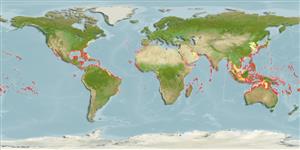>
Lophiiformes (Anglerfishes) >
Antennariidae (Frogfishes)
Etymology: Histrio: Latin, histrionicus = related with actors; because of the movements of that mekaes this fish before catching its preys (Ref. 45335).
More on author: Linnaeus.
Environment: milieu / climate zone / depth range / distribution range
экология
морской ассоциированный с рифами; мигрирует в океане (Ref. 51243); пределы глубины 0 - 50 m (Ref. 58302), usually 0 - 2 m (Ref. 58302). Subtropical; 46°N - 36°S, -180°W - 180°E
Indian Ocean: tip of South Africa eastward to Indian and Sri Lanka, including the Red Sea, Madagascar, Réunion and Mauritius. Western Pacific: Hokkaido to tropical Australia (as far south as Perth in the west and Sydney in the east), including Taiwan, Philippines, Moluccas, southern Papua New Guinea, Guam, Tonga, New Caledonia and New Zealand; Mariana Islands in Micronesia (Ref. 1602). Occurrence in the eastern Pacific remains problematic. Northwest Atlantic: Canada (Ref. 5951). Western Atlantic: Gulf of Maine to the mouth of the Rio de la Plata, Uruguay. Eastern Atlantic: Azores and off West Africa; record from Vardø, northern Norway (Düben & Koren 1846) is based on a straggler taken northward by the North Atlantic and Norwegian currents.
Size / Вес / Возраст
Maturity: Lm ? range ? - ? cm
Max length : 20.0 cm TL самец/пол неопределен; (Ref. 7251)
колючие лучи спинного плавника (общее число): 3; членистые (мягкие) лучи спинного плавника (общее число): 11-13; колючие лучи анального плавника 0; членистые (мягкие) лучи анального плавника: 6 - 13. Diagnosis: body short and globose; mouth large with many small, villiform teeth; skin naked, but head, body and fins covered with numerous skin flaps; very long pelvic fins (> 25% SL); unprotected illicium or lure attains less than half of second dorsal-fin spine and 4.5-9.3% of SL (Ref. 57225).
Found near the surface, usually associated with floating objects (Ref. 26340) or Sargassum. Found near shore and occasionally among floating seaweeds (Ref. 57225). Commonly blown into shore and bay waters during storms (Ref. 7251). Epipelagic (Ref. 58302). A solitary (Ref. 26340) and voracious predator (Ref. 5521). They feed on fishes and shrimps that seek refuge in the floating weeds (Ref. 48635). Oviparous. Eggs are bound in ribbon-like sheath or mass of gelatinous mucus called 'egg raft' or 'veil' (Ref. 6773, 48635). Solitary or loose groups among floating seaweed (Ref 90102).
Life cycle and mating behavior
половая зрелость | размножение | нерест | икра | Fecundity | личинки
Oviparous. During courtship, the male follows the female closely then both rush to the surface to spawn (Ref. 205). At this point, eggs are produced in a gelatinous floating mass or 'raft' and inseminated by the male. The eggs remain embedded in this raft until hatching (Ref. 240).
Pietsch, T.W. and D.B. Grobecker, 1987. Frogfishes of the world. Systematics, zoogeography, and behavioral ecology. Stanford University Press, Stanford, California. 420 p. (Ref. 6773)
Статус Красного Списка МСОП (Ref. 130435)
Угроза для людей
Reports of ciguatera poisoning (Ref. 30911)
Использование человеком
рыболовство: рыболовство как средство для существования; аквариум: коммерческий
дополнительная информация
ссылкиаквакультура (рыбоводство)особенности рыбоводствастепень растяжениягенетикаElectrophoresesнаследуемостьболезниобработкаNutrientsMass conversion
инструменты
Специальные отчеты
Скачать в формате XML
ресурсы в Интернет
Estimates based on models
Preferred temperature (Ref.
123201): 21.4 - 29.2, mean 27.7 °C (based on 4840 cells).
Phylogenetic diversity index (Ref.
82804): PD
50 = 1.0000 [Uniqueness, from 0.5 = low to 2.0 = high].
Bayesian length-weight: a=0.01995 (0.00906 - 0.04395), b=3.01 (2.83 - 3.19), in cm total length, based on all LWR estimates for this body shape (Ref.
93245).
Trophic level (Ref.
69278): 3.9 ±0.63 se; based on food items.
устойчивость к внешним воздействиям (Ref.
120179): высокий, минимальное время удвоения популяции до 15 месяцев (Fec assumed to be > 10,000).
Fishing Vulnerability (Ref.
59153): Low vulnerability (10 of 100).
Nutrients (Ref.
124155): Calcium = 35.4 [15.8, 77.9] mg/100g; Iron = 0.641 [0.325, 1.216] mg/100g; Protein = 19.4 [16.9, 22.5] %; Omega3 = 0.169 [0.062, 0.449] g/100g; Selenium = 12 [5, 31] μg/100g; VitaminA = 107 [26, 451] μg/100g; Zinc = 0.751 [0.443, 1.227] mg/100g (wet weight);
